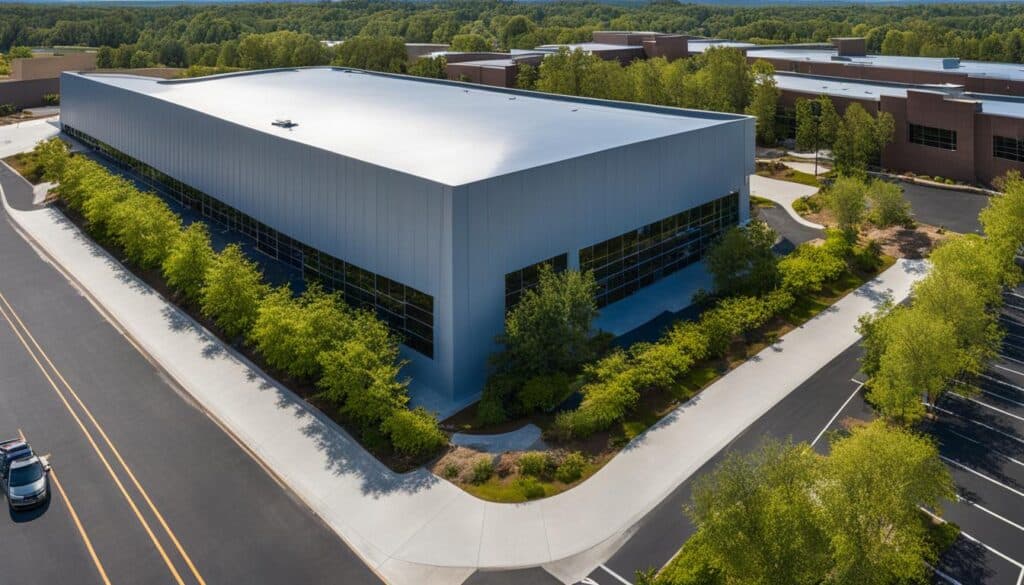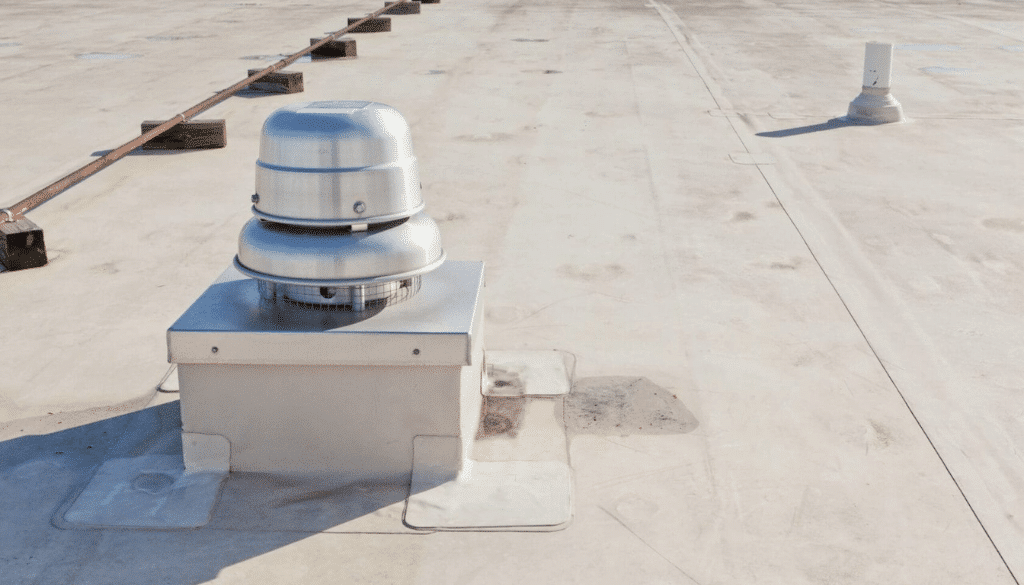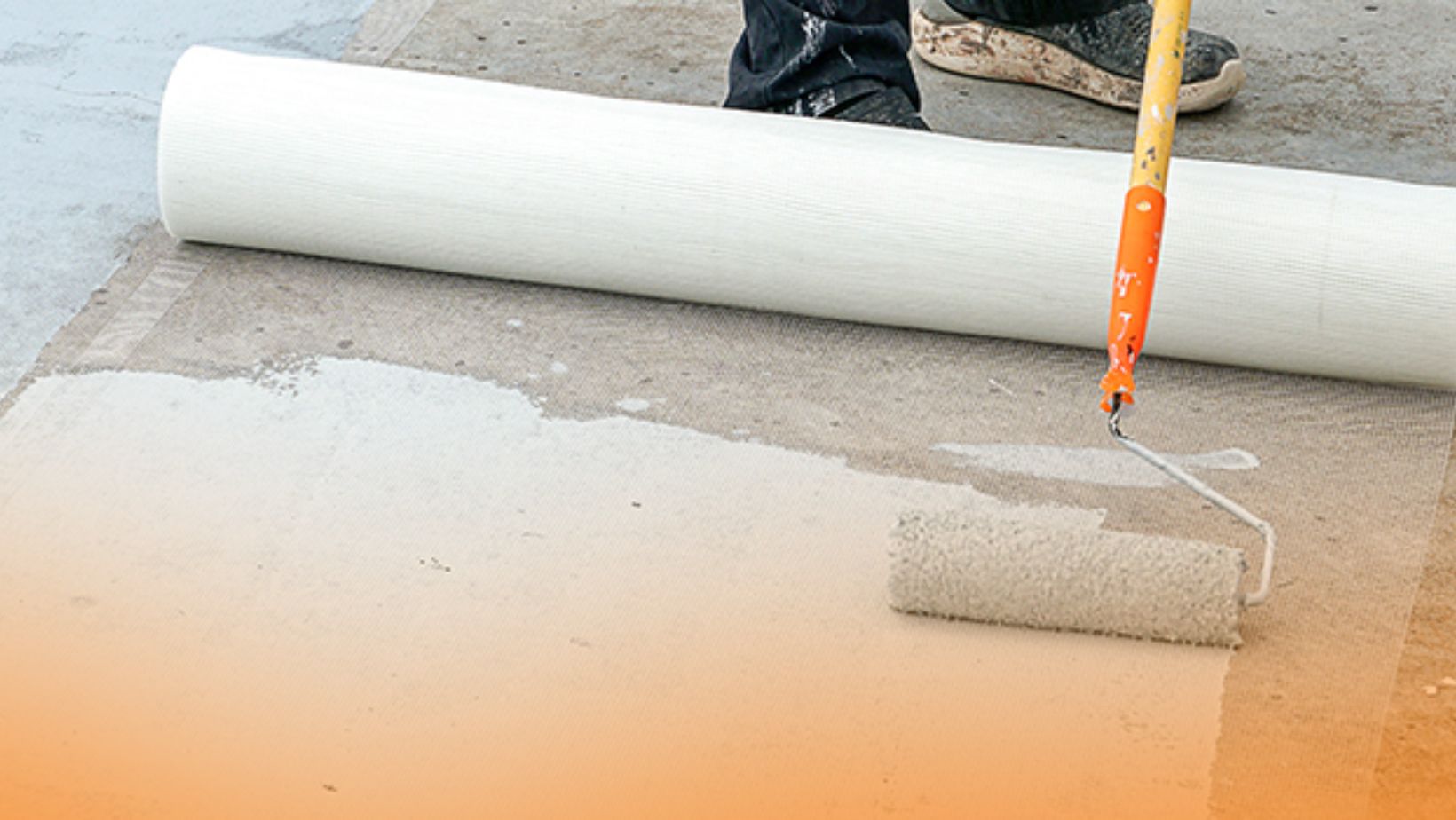At SmartSeal, we are experts with insulating roof coatings. In this article, we will teach you about thermal insulating roof coatings! If you are looking to improve the energy efficiency and sustainability of your building, thermal insulating roof coatings are the perfect solution. These coatings can not only help reduce your energy consumption but also keep your commercial building cool in the summer and warm in the winter. In addition, they can increase the lifespan of your roof, saving you money on costly repairs and replacements in the long run.
By applying thermal insulating roof coatings, you can transform your roof into an energy-efficient shield that keeps your commercial property comfortable and protected all year round. Whether it’s scorching summer heat or freezing winter temperatures, these coatings provide an extra layer of insulation, reducing the need for excessive heating or cooling.
Not only do thermal insulating roof coatings benefit you as a property owner, but they also contribute to a more sustainable future. By reducing energy consumption, these coatings help lower carbon emissions and promote environmental protection. Installing thermal insulating roof coatings is a small step towards creating a greener, more sustainable world.
Key Takeaways:
- Thermal insulating roof coatings improve energy efficiency and sustainability.
- They reduce energy consumption, keeping your property cool in summer and warm in winter.
- These coatings increase the lifespan of your roof, saving on repairs and replacements.
- Thermal insulating roof coatings contribute to a more sustainable future by reducing carbon emissions.
- By choosing thermal insulating roof coatings, you can enjoy a comfortable building while reducing your environmental impact.
Types of Roof Coverings and Cool Options
Cool roof coverings are a popular choice for building owners looking to improve the energy efficiency and comfort of their properties. These innovative roofing materials are designed to reflect more sunlight and absorb less heat, keeping the interior of the building cooler and reducing the need for excessive air conditioning.
When it comes to cool roof coverings, there are several options available for different types of roofs. Let’s explore some of the cool options for popular roofing materials:
| Roofing Material | Cool Options |
|---|---|
| Asphalt Shingles | Light-colored or cool-colored granules |
| Wood Shingles | Naturally “cool colored” options |
| Polymer Shingles | Factory-colored with light- or cool-colored pigments |
| Clay Tiles | Natural cool color or factory-fired light- or cool-colored glaze |
| Concrete Tiles | Factory-applied light- or cool-colored slurry or polymer coating |
| Slate Tiles | Natural cool color options |
| Metal Shingles | Factory coated with a light- or cool-colored paint or reflective mineral granules |
The color choice also plays a significant role in the coolness of the roof. White roofing products reflect the most sunlight, thus keeping the roof surface cooler. However, even dark materials can be made cooler by incorporating special pigments that enhance their solar reflectance.
Now, let’s take a closer look at each type of roof covering and explore their cool options:
- Asphalt Shingles: These are the most commonly used roof coverings in the United States. They are available in various colors and styles, including cool options with light-colored or cool-colored granules.
- Wood Shingles: Wood shingles provide a natural and rustic look to a building. Some wood shingles are naturally “cool colored,” helping to reduce heat absorption.
- Polymer Shingles: Polymer shingles are lightweight and durable, offering excellent resistance to weathering. They are available in factory-colored options with light- or cool-colored pigments.
- Clay Tiles: Clay tiles are known for their timeless beauty and durability. They come in a range of colors, including natural cool color options or those with factory-fired light- or cool-colored glaze.
- Concrete Tiles: Concrete tiles are a versatile option with excellent longevity and durability. They can be factory-applied with a light- or cool-colored slurry or polymer coating, enhancing their energy efficiency.
- Slate Tiles: Slate tiles are a premium roofing option known for their elegance and longevity. They come in various natural cool color options, providing excellent thermal performance.
- Metal Shingles: Metal shingles offer outstanding durability and resistance to extreme weather conditions. They can come factory coated with a light- or cool-colored paint or reflective mineral granules, enhancing their energy efficiency.
Choosing a cool roof covering not only helps to keep your property cooler and more comfortable but also contributes to energy savings and a more sustainable environment.
Cool Roofing Products for Steep Roofs
For steep roofs with a pitch greater than 2:12, there are cool options available for various roofing materials. These include asphalt shingles with light-colored or cool-colored granules, wood shingles that are naturally “cool colored,” polymer shingles factory-colored with light- or cool-colored pigments, clay tiles with a natural cool color or factory-fired light- or cool-colored glaze, concrete tiles with a factory-applied light- or cool-colored slurry or polymer coating, and metal shingles or tiles factory coated with a light- or cool-colored paint or reflective mineral granules, all of which can be enhanced with SmartSeal for improved performance and durability.

When it comes to steep roofs, property owners have a variety of cool roofing products to choose from. These options not only provide protection and durability but also contribute to energy efficiency. Metal shingles, for example, offer excellent solar reflectance and can lower the temperature of your roof. Asphalt shingles with light-colored or cool-colored granules can help reduce heat absorption, keeping your building cooler during hot summer months.
Wood shingles, clay tiles, and concrete tiles also offer cool options for steep roofs. Wood shingles naturally have a cool color that helps reflect sunlight, while clay and concrete tiles can be factory-fired or factory-applied with light- or cool-colored coatings or glazes to enhance their energy-saving properties.
Lastly, polymer shingles come in various colors, including light- or cool-colored pigments, making them suitable for steep roofs in hot climates. These shingles are designed to reflect sunlight, reducing the amount of heat transferred into your building.
Cool Roofing Products for Low-Sloped Roofs
Low-sloped roofs with a pitch less than or equal to 2:12 can also benefit from cool roofing products. These products are designed to help regulate the temperature of your building, improve energy efficiency, and extend the lifespan of your roof.
There are several options available for low-sloped roofs:
- Single-Ply Membranes: These roofing membranes are factory-colored with light- or cool-colored pigments, providing a reflective surface that helps reduce heat absorption. Single-ply membranes are durable, easy to install, and offer excellent waterproofing properties.
- Built-Up Roofs: Built-up roofs can be enhanced with a factory-applied reflective mineral surface or reflective coating. This added layer of reflectivity helps to lower the roof temperature and minimize solar heat gain.
- Modified Bitumen Sheet Membranes: Modified bitumen sheet membranes can also be factory-applied with a reflective mineral surface or reflective coating. This coating helps to reflect sunlight and reduce the amount of heat transferred into the building.
- Spray Polyurethane Foam Roofs: Spray polyurethane foam roofs can be coated with reflective protective coatings. These coatings reflect the sun’s heat, keeping the roof cooler and reducing the energy needed to cool the building.
With the right cool roofing product for your low-sloped roof, you can significantly improve your building’s energy efficiency and save on cooling costs.
Green (Vegetative) Roofs
Green roofs offer a unique and environmentally-friendly approach to improving energy efficiency and sustainability in your commercial property. These innovative roof systems can vary in complexity, ranging from a basic layer of plant cover known as an extensive vegetative roof to more elaborate designs that include gardens or even small trees, known as an intensive vegetative roof.
Green roofs serve multiple purposes beyond their energy-saving benefits. They help manage stormwater runoff by absorbing rainwater and reducing the strain on drainage systems. Additionally, green roofs provide a visually appealing and functional space for recreational activities, gardening, and relaxation.
However, before considering the installation of a green roof, it is essential to conduct a thorough assessment of your property and building structure to ensure feasibility. Green roofs require ongoing maintenance, including regular watering, pruning, and pest control, to ensure the healthy growth and longevity of the vegetation.

| Type of Green Roof | Description and Characteristics |
|---|---|
| Extensive Vegetative Roof | A basic green roof with a thin layer of soil supporting low-maintenance plants such as grasses, herbs, and sedums. Requires minimal maintenance and provides energy-saving benefits. |
| Intensive Vegetative Roof | A more elaborate green roof that supports a diverse range of plant species, including larger plants and even trees. Requires regular maintenance and offers additional benefits such as improved air quality and enhanced biodiversity. |
Benefits of Installing a Roof Coating System
Installing a roof coating system offers numerous benefits. It can reduce energy consumption by reflecting sunlight and providing extra insulation. Roof coatings also lower the need for roof maintenance and repairs, improve the appearance of the roof, keep roofing components in good condition, reduce roof noise, increase the lifespan of the roof, protect the environment, offer affordability, are easy to maintain, and improve the value of your building.

Roof coating systems are an excellent investment for owners looking to maximize energy efficiency and protect their roofs. By applying a quality roof coating, you can significantly reduce energy consumption by reflecting the sun’s rays, keeping your unit cooler in the summer and reducing the need for excessive air conditioning. Additionally, the extra insulation provided by the coating helps keep your building warm during the colder months, reducing heating costs.
In addition to energy savings and improved appearance, roof coatings contribute to a quieter living environment. The coating acts as a sound barrier, reducing the impact of outside noise such as rain, hail, and wind. This creates a more peaceful and comfortable living space, enhancing the overall quality of life for you and your family.
Roof coatings are also highly affordable, especially when compared to the cost of roof replacement. A coating can be applied directly on top of your existing roof, eliminating the need for costly tear-offs and reducing labor expenses. Additionally, the easy maintenance of roof coatings further contributes to their affordability, as they require minimal cleaning or repairs over time.
Lastly, installing a roof coating system can improve the property. With the added benefits of energy efficiency, aesthetics, and increased lifespan, potential buyers will be drawn to a property with a well-maintained and energy-efficient roof. This can translate into a higher resale value and a quicker sale when the time comes.
Overall, a roof coating system is a wise investment that offers a range of benefits for owners. From energy savings and environmental protection to improved roof appearance and increased value, the advantages of installing a roof coating system are clear. Consider the long-term benefits and savings that a roof coating system can provide, making it a valuable addition to any building.
How to Choose the Right Roof Coating for Your Commercial Property
Choosing the right roof coating for your commercial property is an important decision that can have a significant impact on the performance and longevity of your roof. Factors such as the roof type, climate, budget, and desired reflectivity should all be considered when making your selection. Different roof coatings offer unique benefits, so it’s essential to choose one that best suits your specific requirements.
In areas with high temperatures and intense sunlight, reflectivity becomes a crucial consideration. White or light-colored roof coatings, such as acrylic and elastomeric coatings, have high reflectivity and can help keep your building cooler by reflecting solar heat. These coatings are especially beneficial for units in warm climates, where reducing cooling costs is a priority.
When it comes to budget considerations, asphalt roof coatings are generally more cost-effective compared to other options. They offer good protection and can be an affordable solution for owners with tight budgets. However, it’s important to keep in mind that the longevity and performance of the coating should also be taken into account when making your decision.
Lastly, the climate of your region should influence your choice of roof coating. If you live in an area with frequent rainfall or high humidity, choosing a roof coating with excellent waterproofing properties, such as silicone or polyurea, is crucial to prevent leaks and water damage.
In summary, selecting the right roof coating entails considering the type of roof, climate, budget, and desired reflectivity. Whether it’s an acrylic coating for an asphalt shingle roof, a silicone coating for a metal roof, or a white elastomeric coating for improved reflectivity, there are options available to meet your specific needs. Consulting with a professional roofer can provide valuable insights and help you make an informed decision that will protect and enhance your property for years to come.
Reasons to Choose Thermal Roof Coating
Thermal roof coating offers several compelling reasons for building owners to choose it. It improves energy efficiency by reducing heat loss and enhancing insulation. This, in turn, leads to significant cost savings on energy bills. Thermal roof coating also helps protect the environment by reducing carbon emissions. Additionally, it extends the longevity of the roof, requires low maintenance, and provides an aesthetically pleasing finish.
By reducing heat loss and enhancing insulation, thermal roof coating plays a crucial role in improving energy efficiency. It forms a protective barrier on the roof’s surface, preventing heat transfer between the interior and exterior of the building. This insulation capability reduces the need for excessive heating or cooling, resulting in lower energy consumption and cost savings.
One of the key advantages of thermal roof coating is its contribution to environmental protection. By reducing the energy required for temperature control, it helps minimize carbon emissions. This sustainable roofing solution aligns with environmentally-conscious practices, supporting the global effort to reduce our carbon footprint and mitigate the effects of climate change.
In terms of maintenance, thermal roof coating offers a low-maintenance solution for owners. Once applied, it requires minimal upkeep, reducing the time and effort required for roof maintenance tasks. This low-maintenance feature allows owners to enjoy the benefits of a well-protected and energy-efficient roof without the hassle of regular upkeep.
The Thermal Roof Coating Process
The thermal roof coating process involves multiple stages that are carefully executed to ensure the best results. These stages include a risk assessment, roof cleaning, roof renovation, anti-fungicidal wash, and the application of a waterproof thermal roof coating.
First, we begin with a risk assessment and method statement to prioritize safety during the process. This helps us identify any potential risks or hazards and plan accordingly.
Next, we move on to roof cleaning. It’s crucial to start with a clean surface to ensure proper adhesion and effectiveness of the thermal coating. Cleaning may involve the removal of dirt, debris, algae, moss, or any other contaminants that may be present on the roof.
After the roof is thoroughly cleaned, we proceed with any necessary roof renovation. This step involves addressing any underlying issues such as damaged or deteriorated roofing materials, leaks, or structural problems. Repairing or replacing damaged components ensures a solid foundation for the thermal coating.
Once the roof is clean and renovated, we apply an anti-fungicidal wash. This wash helps eliminate any remaining traces of mold, mildew, or fungi, ensuring a clean and sanitized surface. It prevents the growth of these organisms which could potentially damage the roof over time.
Finally, we apply the waterproof thermal roof coating. This coating is designed to provide excellent thermal insulation properties, reflecting sunlight and reducing heat transfer. It helps keep the interior of the building cool during hot weather and prevents heat loss during colder months. The waterproof feature ensures the roof is protected against leaks and moisture damage.
Conclusion
Thermal insulating roof coatings offer property owners a multitude of benefits that make them an excellent investment. These coatings not only contribute to significant energy savings but also provide a more sustainable roof solution. By opting for thermal insulating roof coatings and following the proper application process, property owners can enjoy an efficient and comfortable building while increasing the value and lifespan of their roof.
The energy savings achieved with thermal insulating roof coatings are substantial. By reflecting sunlight and providing additional insulation, these coatings help reduce the need for excessive heating or cooling, resulting in lower energy consumption and cost savings. Moreover, the improved temperature control ensures a more comfortable living environment all year round.
In addition to energy efficiency, thermal insulating roof coatings contribute to sustainability. They enhance the overall sustainability of a roof by reducing carbon emissions, as lower energy consumption translates into a reduced environmental impact. This eco-friendly choice aligns with the growing trend towards sustainable living and a greener future.
By investing in thermal insulating roof coatings, owners not only benefit from energy savings and a sustainable roof but also enhance the value and lifespan of their property. These coatings provide an extra layer of protection that helps safeguard the roof against various weather conditions, preventing premature deterioration. With proper maintenance, owners can enjoy a beautiful and durable roof for years to come.
Does your Lakeland building need a new roof? SmartSeal is Lakeland’s top commercial roof coating contractor, and the go-to for businesses throughout Florida. Contact us today to get started.
FAQs
What are thermal insulating roof coatings?
Thermal insulating roof coatings are coatings that improve the energy efficiency and sustainability by reducing energy consumption, providing extra insulation, and reflecting sunlight.
What types of roofs can benefit from cool roof coverings?
Cool roof coverings can be applied to various types of roofs, including asphalt shingles, wood shingles, polymer shingles, clay tiles, concrete tiles, slate tiles, and metal shingles.
How do cool roof coverings impact the temperature of a building?
Cool roof coverings can help keep a building cool in the summer by reflecting sunlight and reducing heat absorption. In the winter, they can help keep a building warm by enhancing insulation.
What cool options are available for steep roofs?
For steep roofs with a pitch greater than 2:12, cool options include light-colored or cool-colored granules for asphalt shingles, naturally “cool colored” wood shingles, light- or cool-colored pigments for polymer shingles, light- or cool-colored glaze for clay tiles, light- or cool-colored slurry or polymer coating for concrete tiles, and light- or cool-colored paint or reflective mineral granules for metal shingles or tiles.
How can low-sloped roofs benefit from cool roofing products?
Low-sloped roofs with a pitch less than or equal to 2:12 can benefit from cool roofing products such as single-ply membranes with light- or cool-colored pigments, built-up roofs with a reflective mineral surface or reflective coating, modified bitumen sheet membranes with a reflective mineral surface or reflective coating, and spray polyurethane foam roofs with reflective protective coatings.
What are green roofs and how do they improve energy efficiency?
Green roofs range from basic plant cover to gardens or small trees and can help manage stormwater and create attractive rooftop spaces. They improve energy efficiency by providing additional insulation and reducing heat absorption.
What are the benefits of installing a roof coating system?
Installing a roof coating system can reduce energy consumption, lower the need for roof maintenance and repairs, improve the appearance of the roof, keep roofing components in good condition, reduce roof noise, increase the lifespan of the roof, protect the environment, offer affordability, and improve the value.
What factors should I consider when choosing a roof coating for my business building?
Factors to consider when choosing a roof coating include the type of roof, climate, budget, and desired reflectivity. Different roof coatings, such as acrylic, asphalt, elastomeric, silicone, and polyurea, offer their own benefits and can be chosen based on specific requirements.
What are the reasons to choose thermal roof coating?
Thermal roof coating improves energy efficiency by reducing heat loss and enhancing insulation, leading to significant cost savings on energy bills. It also helps protect the environment by reducing carbon emissions, extends the longevity of the roof, requires low maintenance, and provides an aesthetically pleasing finish.
What is the process for applying thermal roof coating?
The thermal roof coating process begins with a risk assessment and method statement for safety and planning. It includes roof cleaning, roof renovation, application of an anti-fungicidal wash, and finally, the application of a waterproof thermal roof coating to ensure the best results.
What benefits do thermal insulating roof coatings offer property owners?
Thermal insulating roof coatings offer benefits such as energy savings, a more sustainable roof, and improved temperature control, resulting in a more efficient and comfortable building while increasing the value and lifespan of the roof.



